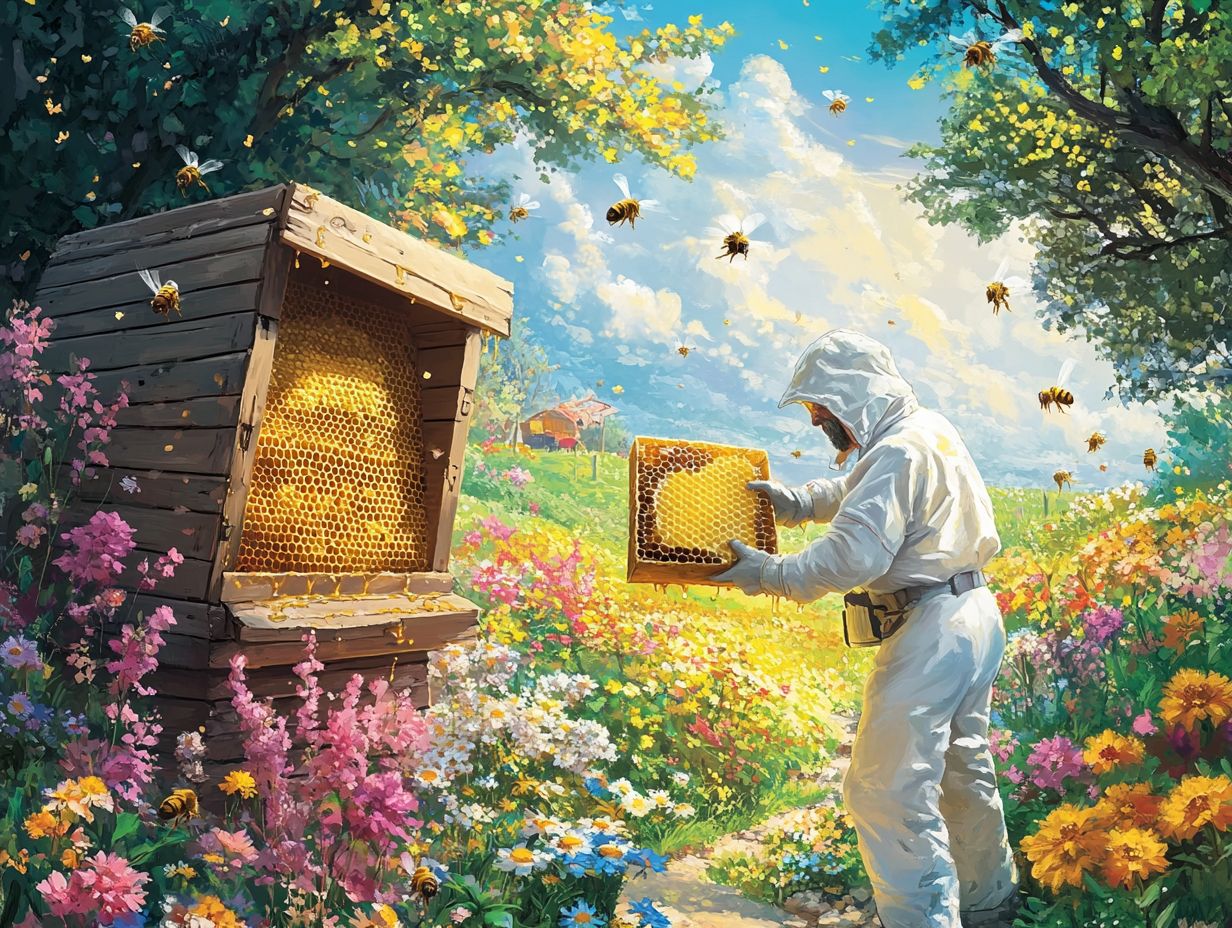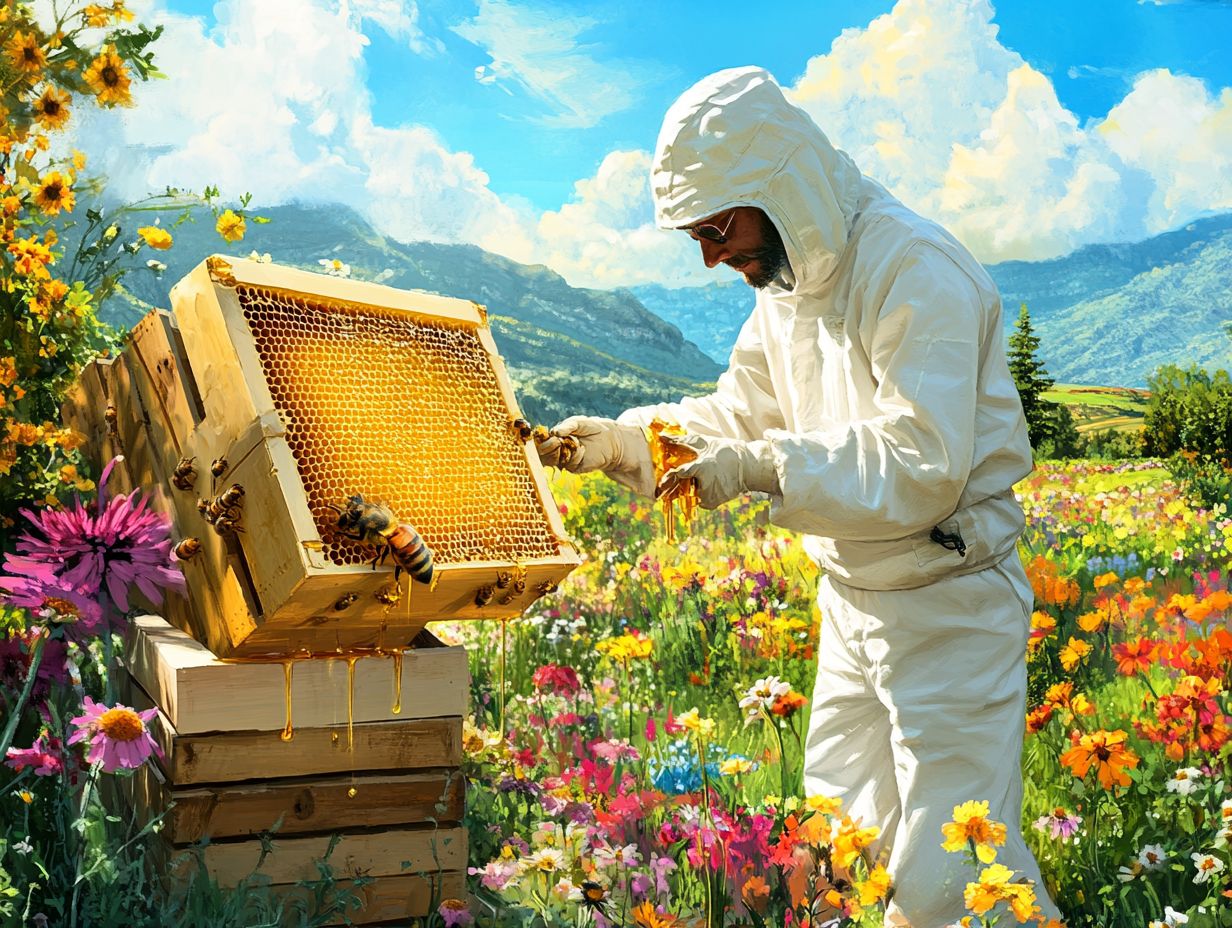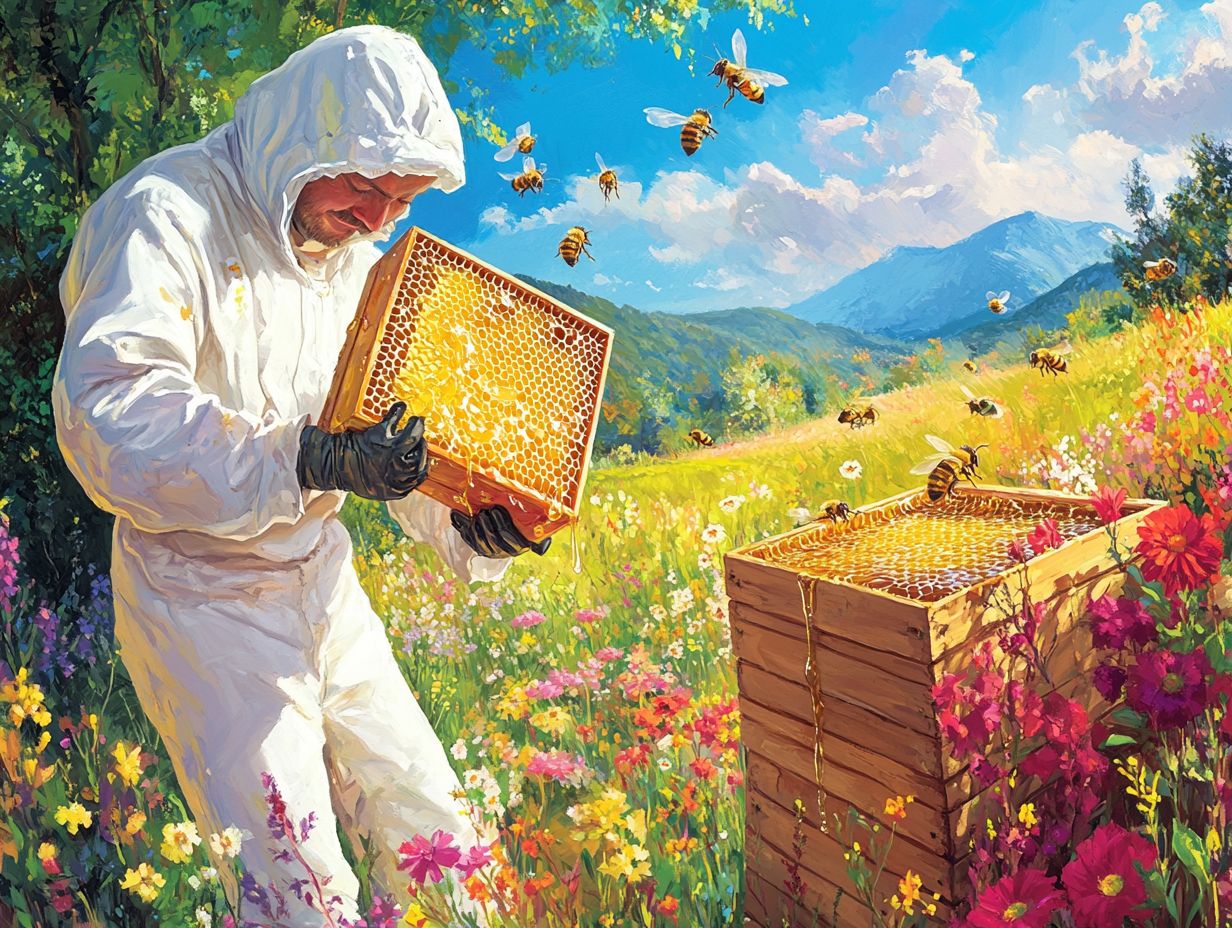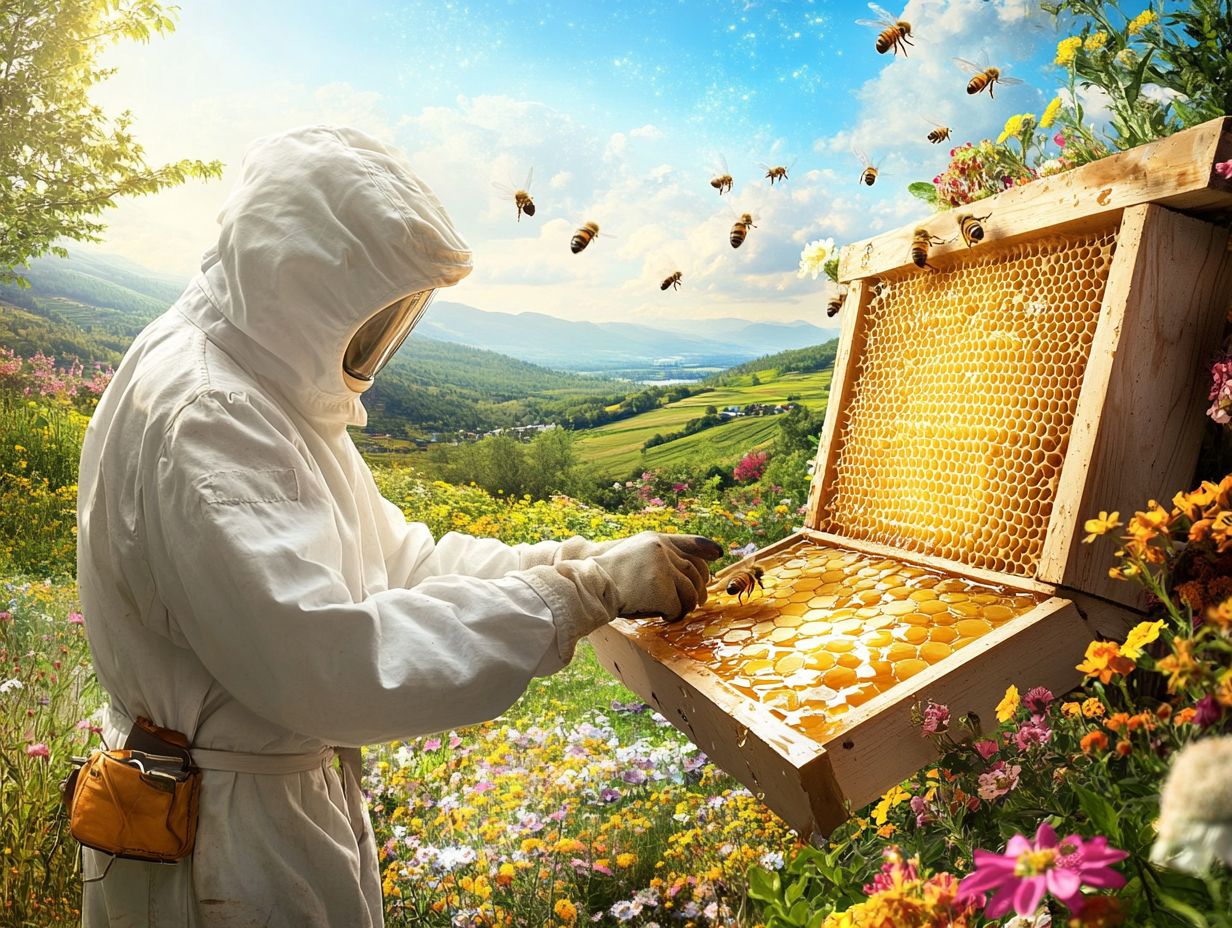The Art of Beekeeping: From Hive to Honey
Dive into the wonderful world of beekeeping and discover the magic of bees! Beekeeping is an enchanting fusion of science, nature, and craftsmanship. It offers a rewarding pursuit for anyone curious about the captivating world of bees.
This guide delves into the different types of bees essential for beekeeping. You’ll find the must-have equipment you’ll need to embark on this journey and the practical steps for setting up your hive.
It also explores the honey harvesting process and addresses common challenges beekeepers encounter. Additionally, it highlights the myriad benefits this ancient practice brings.
Whether you’re a seasoned enthusiast or just beginning to explore this fascinating craft, there’s something here tailored just for you!
Contents
Key Takeaways:
- Beekeeping is a diverse practice that involves different types of bees, such as honey bees, bumble bees, and stingless bees. Each type plays a unique role in the hive and contributes to honey production.
- Having the right equipment is essential for successful beekeeping. A beehive, beekeeping suit, smoker, and hive tool are some of the basic tools needed to manage a hive.
- Before starting beekeeping, carefully select the location, obtain bees from a reputable source, and set up the hive. These steps are crucial for the long-term success of the hive and honey production.
Types of Bees Used in Beekeeping
Let’s explore the different bees that make beekeeping so special. In the captivating realm of beekeeping, you’ll discover that various types of bees are essential to honey production and the vitality of the hive.
Honey bees, bumble bees, and stingless bees each fulfill distinct roles. They enhance pollination and enrich the diverse ecosystem that supports beekeeping.
Their unique behaviors and physical characteristics are fascinating and crucial for effective hive management and sustainability.
Honey Bees
Honey bees serve as the backbone of the beekeeping industry. They are celebrated for their intricate hive management and sophisticated communication systems centered around the Queen bee.
Imagine a colony functioning as a meticulously organized society. Every member has a specific role that contributes to the hive’s overall welfare and productivity. Worker bees engage in vital tasks, from foraging for nectar and pollen to cleaning and maintaining the hive.
Their unwavering dedication profoundly impacts honey production. Drones play their part in reproduction, while the Queen focuses on nurturing the next generation.
This social structure boosts their efficiency in resource management. It highlights the critical role each bee plays in maintaining the delicate balance essential for thriving hives and, ultimately, the broader ecosystem.
Bumble Bees
Bumble bees are essential pollinators. They play an invaluable role in the ecosystem that supports your outdoor activities and farming through their remarkable pollination abilities.
Unlike honey bees, which thrive in large colonies and produce honey, bumble bees prefer to establish smaller nests. These nests are often tucked away underground or nestled in dense vegetation.
This unique nesting behavior, combined with their knack for pollinating a variety of plants, makes them particularly effective across diverse habitats, even in cooler temperatures.
While both honey bees and bumble bees significantly contribute to environmental health, bumble bees truly shine in early spring. They ensure wildflowers bloom and crops flourish abundantly.
Protecting these pollinators is crucial. They enhance agricultural productivity and play a vital role in sustaining the ecosystems that support your favorite outdoor activities, like hiking and gardening.
Stingless Bees
Stingless bees may not be the stars of the honey world, but they are invaluable contributors. In regions where sustainable practices thrive, these fascinating insects help create unique honey varieties.
They typically inhabit smaller, less aggressive colonies, making them easy to manage for beekeepers focused on eco-friendly methods. Their honey, rich in antioxidants and unique flavors, adds delight to local diets and plays a vital role in supporting biodiversity.
Consider the honey produced by stingless bees, such as the sought-after ‘Melipona’ honey, celebrated for its health benefits, including anti-inflammatory properties. Promoting local honey enhances community health and fosters sustainable agriculture, ensuring the preservation of these essential pollinators.
Equipment Needed for Beekeeping
If you want to be a successful beekeeper, you need the right equipment. Here’s what you’ll need:
- Beehives
- Protective suits
- Smokers to calm the bees
- Specialized hive tools for effective management
Each piece of equipment plays a crucial role in creating a thriving environment for your bees.
Beehive
A well-structured beehive is essential for effective hive management and optimal honey production. It serves as a sanctuary for honey bees and supports vital activities within the colony.
The design of your hive not only affects the bees’ daily routines but also impacts their overall well-being. Key components like the brood chamber, honey supers, and ventilated frames are crucial for maintaining proper temperature and humidity levels, both vital for healthy brood development.
When you invest in a thoughtfully designed hive, you can enhance mite control, keeping those pesky intruders at bay. Features like screened bottom boards and moisture management systems create an environment that maximizes productivity, leading to superior honey yields and robust bee populations.
Beekeeping Suit
A beekeeping suit is essential protective gear that ensures your safety from bee stings while managing your hives efficiently. This suit is your first line of defense against those pesky stings!
The materials—typically a blend of cotton and synthetic fibers—are crafted to be lightweight and durable, providing comfort during those long hours in the apiary. It’s especially important during hive inspections and honey extraction, where being close to the bees can trigger their defensive instincts.
Investing in a quality suit not only enhances your safety; it fosters a more harmonious relationship with your buzzing companions. This leads to better practices in beekeeping, making your experience enjoyable and productive.
Smoker
A smoker is an essential tool in your beekeeping kit. It calms bees during hive management by masking the alarm pheromones they release when threatened.
This device produces cool smoke, typically from burning organic materials like wood chips or paper. The gentle smoke distracts and soothes the bees. When you puff smoke into the hive, it signals the bees to focus on consuming honey in preparation for a potential evacuation, rather than becoming defensive.
By reducing aggressive reactions, the smoker significantly enhances the safety of your hive inspections, allowing you to carry out necessary tasks efficiently. Using a smoker not only keeps you safe but also helps your bees thrive!
Hive Tool
A hive tool is truly essential for you as a beekeeper. It grants the leverage you need to open hives, inspect colonies, and perform honey extraction with ease.
This essential tool comes in various designs, each carefully designed for specific hive management tasks. Some tools sport a sharp edge for scraping away propolis and wax, while others feature a pry bar function that allows you to separate frames without compromising the delicate structure of the hive.
These tools streamline your inspection process and help minimize stress on the bees during management activities. By using hive tools efficiently, you can enhance the overall health of your colonies, optimize honey production, and ensure your apiary thrives productively.
How to Start Beekeeping
Embarking on a beekeeping venture requires careful consideration of several essential steps. You’ll want to begin by selecting the ideal location for your hives, ensuring it offers both accessibility and a nurturing environment for your bees.
Next, acquiring healthy bees is crucial; they are the backbone of your operation. Finally, setting up the hive to facilitate optimal management and honey production will be key to your success. Each of these elements plays a vital role in creating a thriving beekeeping experience.
Choosing the Right Location
Choosing the ideal location for your beekeeping setup is paramount. It directly influences the environmental factors that affect bee health and nectar production.
When selecting your site, consider how close it is to abundant flowering plants. These plants are essential, providing the pollen and nectar that form the backbone of your bees’ diet. Ensure that accessible water sources are nearby, as bees need water for hydration and to regulate hive temperature.
The local climate also plays a crucial role. Warmer regions can accelerate brood development, while a diverse array of flora can boost honey production. It’s vital to steer clear of areas with heavy pesticide use; these chemicals can severely impair bee physiology and overall health.
Obtaining Bees
Obtaining healthy bees is a vital first step in your beekeeping journey, whether you purchase a package of bees, a nucleus colony, or raise your own from a queen bee.
Each of these methods offers unique advantages, such as convenience or genetic diversity. However, your selection must prioritize strong, resilient stock to mitigate risks associated with challenges like colony collapse disorder.
By choosing reputable suppliers or taking the initiative to raise your own bees, you significantly increase the chances of cultivating a thriving colony, essential not only for honey production but also for valuable pollination services.
Ultimately, the health of your bees will directly influence the success and sustainability of your honey business, making it imperative to invest in robust and well-adapted bee populations.
Setting Up the Hive
Setting up your hive correctly is essential for the survival and productivity of your bee colony. Proper architecture supports a healthy brood pattern.
You’ll want to carefully consider the spacing between frames to promote optimal movement and airflow—both of which are crucial for maintaining the desired temperature and humidity levels within the hive.
Incorporating proper ventilation into the design is equally important to prevent moisture buildup that can create harmful conditions for your bees. Positioning your hive in a spot that receives ample sunlight while also offering shelter from harsh winds can significantly enhance your bees’ foraging efficiency.
This thoughtful placement ultimately contributes to a more robust and thriving colony.
Harvesting Honey from the Hive
Harvesting honey is a fulfilling endeavor that requires careful timing and a range of techniques to ensure the highest quality in both extraction and storage for selling. Each step in the process enhances your experience and prepares your honey for the market.
This is not just a task; it’s an exciting adventure that connects you with nature.
When to Harvest Honey
Knowing when to harvest honey is crucial. It maximizes nectar production and ensures your honey is of the finest quality.
Several signs can guide you in determining the perfect moment for harvesting. These often align with natural events like the goldenrod bloom, a vital source of abundant nectar for your bees. As late summer transitions into early fall and goldenrod flowers begin to bloom, you’ll notice a significant uptick in nectar flow. This amplifies the bees’ foraging activity.
It’s essential to monitor the hive for capped frames, which are frames with honey cells sealed with wax. When around 80% of the cells are sealed, it’s a clear indication that the honey has achieved the ideal moisture content and is ready for harvest.
Understanding your colony’s behavior—such as their activity levels and the amount of pollen they’re bringing in—can provide invaluable insights into the honey production cycle. This knowledge helps you know exactly when to gather different honey types, each boasting unique flavors and qualities.
Methods of Harvesting Honey
You can use various methods of harvesting honey to ensure effective extraction while prioritizing the health of your bee business.
Each technique—be it a traditional honey extractor, crushing and straining, or gravity draining—affects not only the quality of the honey but also the well-being of your bees. For example, using a centrifugal honey extractor provides a gentler approach, minimizing disturbance to the hive and allowing the bees to maintain their natural behaviors. In contrast, simpler techniques like crushing can stress the colony if not executed with care.
The right tools, from the extractor to protective gear and hive tools, are essential for optimizing your harvesting process. This safeguards both the honey’s quality and the bees’ health.
Storing and Selling Honey
Store and sell your honey the right way to keep it fresh and delicious. Proper storage preserves its quality and showcases the unique health benefits tied to local honey varieties.
As a vendor, use airtight containers and keep honey in a cool, dark place. This significantly extends its shelf life, ensuring that your customers receive the freshest product possible. Clear and informative labels detailing the source and health benefits greatly enhance consumer trust.
Consider marketing strategies that highlight the varied medicinal properties of local honey, such as its ability to combat allergies or soothe sore throats. This approach can effectively drive sales. By educating potential customers about the nutritional values and unique qualities of your local honey, you can cultivate a deeper connection between the community and your offerings.
Common Challenges in Beekeeping
As a beekeeper, you frequently encounter various challenges that can test your resilience and expertise.
From threats posed by predators and pests to the impact of diseases and fluctuating environmental conditions, each factor can significantly affect the health and productivity of your bees.
Predators and Pests
Predators and pests present significant threats to your bee colonies. Effective mite control and management strategies are necessary to tackle challenges like American foulbrood.
These issues can strain the overall health of your bees, diminishing their foraging and pollination capabilities. Various parasites, particularly Varroa mites, latch onto the bees, weakening the colony and making it vulnerable to diseases. Meanwhile, the presence of wasps and other predatory insects can further jeopardize hive survival by preying on adult bees and larvae.
As a beekeeper, remain vigilant in monitoring your colonies and implement simple pest control methods. This includes regular observation, appropriate treatments, and creating a thriving environment that supports the health and productivity of your bees.
Diseases and Parasites
The health of your bee colonies is at risk from diseases and parasites, including the well-known colony collapse disorder. This issue can wipe out entire hives if not addressed swiftly.
Stay alert to a range of pathogens and pests, such as the Varroa destructor mite, Nosema, and American foulbrood. Symptoms can manifest as a sudden drop in bee populations, odd behaviors, or discolored brood.
To protect your colonies, adopt integrated pest management techniques and uphold strict hygiene practices.
Choose an approach that supports sustainable beekeeping for the health of your bees!
Weather and Environmental Factors
Weather and environmental factors significantly influence your beekeeping success. They directly affect nectar production and the overall survival of your bee colonies.
Shifts in temperature can alter flowering patterns, impacting the availability of nectar and pollen. Prolonged warmth might encourage early blooms, but an unexpected frost can wipe out those flowers.
Higher humidity and rainfall can lead to pests and diseases, which threaten hive health. Implement effective hive management strategies to adapt to these changes.
Benefits of Beekeeping
Beekeeping offers a wealth of benefits, from the delightful production of honey to its vital role in pollinating plants. It also provides educational and therapeutic advantages that enrich your life and the community.
Production of Honey and Other Bee Products
The production of honey and other bee products is a celebrated part of beekeeping, showcasing a range of honey varieties with unique flavors. Imagine the rich, amber hue of wildflower honey contrasted with the floral notes of lavender-infused options.
Beekeeping also yields treasures like beeswax, known for its versatility in skincare, and propolis, a natural resin valued for its antimicrobial properties.
Raw local honey is especially sought after for its delightful taste and potential health benefits, like allergy relief and antioxidant properties. The demand for local honey has surged, with consumers gravitating toward artisanal products that support regional economies.
Pollination of Plants
Pollination is an essential ecosystem service provided by bees. It enriches nectar production and supports the growth of a variety of plants and crops, especially during the goldenrod bloom. This vital process leads to the formation of seeds and fruits, significantly enhancing agricultural yields worldwide.
By facilitating the reproduction of flowering plants, these hardworking pollinators play a crucial role in maintaining biodiversity. They help ecosystems remain resilient and adaptable to environmental changes. Healthy bee populations contribute to environmental quality by sustaining habitats that support countless other species, highlighting their importance in fostering ecological balance.
Their intricate communication and foraging behaviors amplify their impact on crop variety and sustainability, ultimately benefiting food security and the health of our planet.
Educational and Therapeutic Benefits
Beekeeping is not just a hobby; it’s a thrilling journey into nature that enriches your life! It offers both educational and therapeutic benefits, allowing you to immerse yourself in nature while participating in beekeeping classes. These classes deepen your understanding of bee physiology and behavior.
These sessions cover the science behind hive dynamics and highlight the important job that bees play in our ecosystem. They foster teamwork and community engagement. Schools that integrate beekeeping into their curriculum can become vibrant hubs for experiential learning, offering students hands-on experience and nurturing environmental stewardship.
Therapeutic programs that include beekeeping help you develop patience and mindfulness, creating a soothing connection to the natural world. This way, beekeeping evolves from a simple pastime into a powerful educational resource for diverse communities.
Frequently Asked Questions
What is the Art of Beekeeping?
The Art of Beekeeping is the practice of caring for and managing bees to produce honey, beeswax, and other bee-related products. It involves understanding the behavior and needs of bees, maintaining their hives, and harvesting their products. Resources like David Burns and Sheri Burns provide invaluable insights into this bee business.
What are the different types of hives used in beekeeping?
There are several types of hives used in beekeeping, including the Langstroth hive, the top bar hive, and the Warre hive. Each type has its own advantages and disadvantages, so it’s important to research and choose the best option for your specific needs and location. Understanding the beekeeping terminology can also help in making informed decisions.
How do you start a hive as a beginner beekeeper?
Before starting a hive, do thorough research and prepare. Acquire necessary equipment, choose a good location for your hive, and buy bees from a trusted source.
Consider taking a beekeeping course or joining a local association for support and advice on honey extraction and production.
What are some important safety precautions to take when handling bees?
Wear protective clothing like a beekeeping suit, gloves, and a veil. Avoid dark colors or strong scents, as they can upset the bees.
Move slowly and calmly. Use a smoker to soothe the bees before you start working in the hive.
How do you harvest honey from a hive?
To harvest honey, remove the honeycomb frames from the hive. Extract honey using a honey extractor or by crushing and straining the comb.
Make sure to leave enough honey for the bees, especially to survive the winter months.
What are some benefits of beekeeping?
Beekeeping offers a sustainable source of honey and beeswax while helping pollinate plants. It’s a rewarding hobby that connects you with nature and benefits the environment.
Learning about seasonal tips can enhance your experience as a beekeeper.




